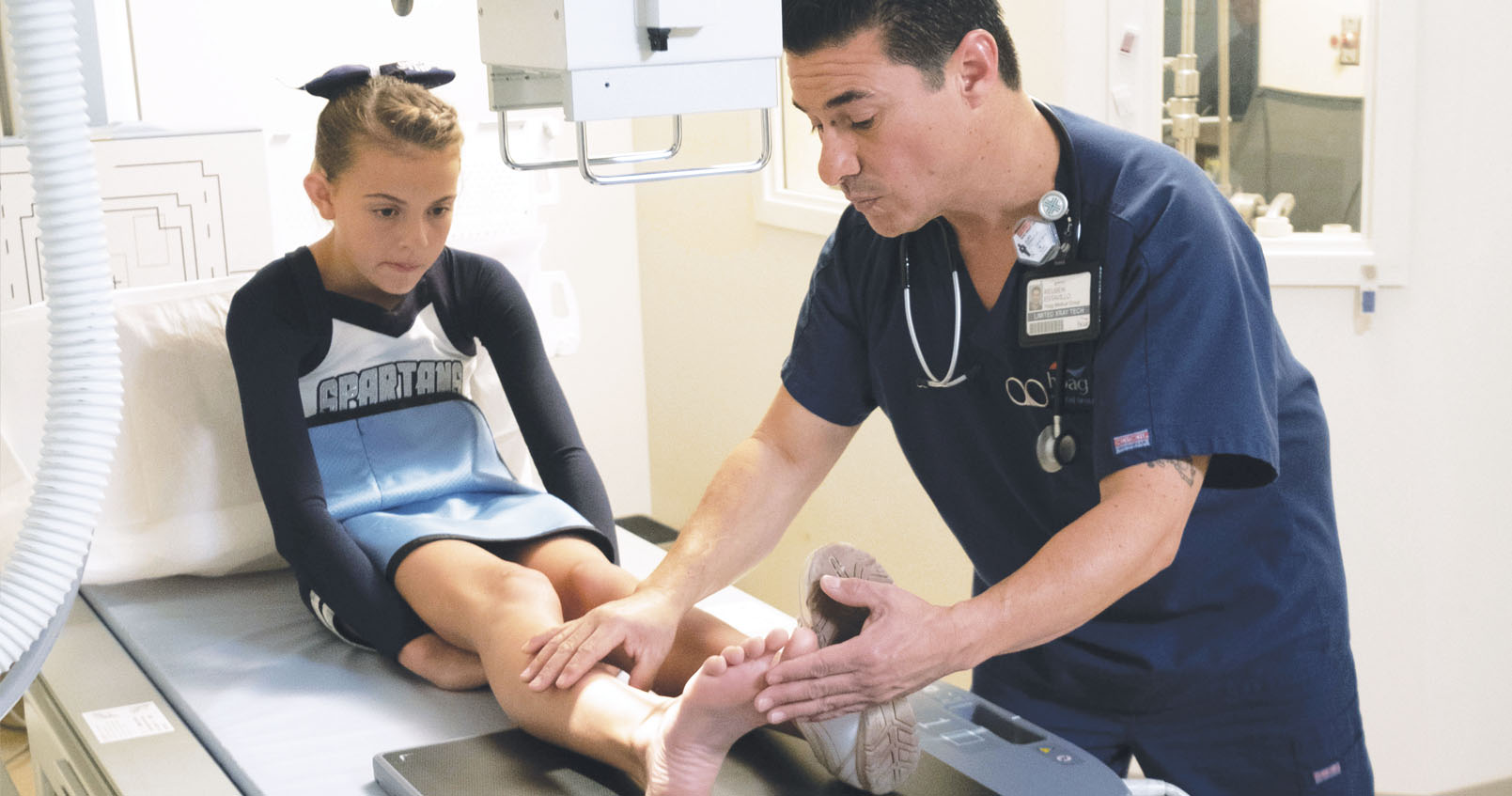What You Need To Know About Sprains
By Bridget Ozman, MD | Hoag Urgent Care

Understanding, Treating, and Preventing Sprains
We’ve all been there: that sudden twist, the awkward landing, and then a jolt of pain followed by swelling and tenderness. Chances are, you’ve experienced a sprain, often confused with a “strain” (which involves muscles or tendons).
A Sprain specifically refers to an injury to a ligament, which can an overstretching or tearing of ligaments. (Ligaments are tough bands of fibrous tissue that connect bones to other bones and stabilize your joints.)
Sprains are a common setback, but with proper understanding, prompt treatment, and proactive prevention strategies, you can minimize their impact and keep your joints healthy and happy. We have been seeing an increase in patients with pneumonia symptoms. As respiratory illnesses tend to spike when the weather turns cold, it’s not surprising to see more cases of pneumonia during the fall and winter months. Pneumonia is a serious infection that affects the lungs, caused by bacteria, viruses (such as COVID-19, influenza, and RSV), or fungi. These infectious agents can enter your lungs through your nose or mouth, leading to inflammation and infection. While it can range from mild to severe, it is a serious condition that requires prompt attention, especially for individuals at higher risk. If you’re experiencing persistent cough, fever, or difficulty breathing, now is the time to seek care.
Causes of Sprains
Sprains most commonly result from trauma resulting from a fall, a sudden twist, or a blow that forces the joint out of its normal position/that stresses a joint beyond its normal range of motion. The severity of a sprain can range from a mild tweak to a severe tear, depends on whether the ligament is stretched, partially torn or completely torn, as well as the number of ligaments involved.
Sprains most often occur in the following circumstances:
- Ankle: Walking or exercising on an uneven surface, landing awkwardly from a jump, when the foot rolls inward, stretching or tearing the ligaments on the outside of the ankle. An ankle is the most common and frequently sprained joint often due to inversion injuries during sports or daily activities.
- Wrist Sprains: Falling onto an outstretched hand is a frequent culprit.
- Knee Sprains: Pivoting during an athletic activity, can happen with sudden twists or direct impact, affecting ligaments like the ACL, PCL, MCL, or LCL.
- Thumb Sprains: Common in sports like skiing, racquet sports such as tennis, basketball, often from hyperextension.
Severity
Sprains are typically graded based on their severity:
- Grade 1 (Mild): Slight stretching and some damage to the ligament fibers. You might have some pain, tenderness, and minor swelling, but joint stability is generally good.
- Grade 2 (Moderate): Partial tearing of the ligament. Expect more pain, significant swelling, bruising, and some loss of function. The joint may feel somewhat unstable.
- Grade 3 (Severe): Complete tear of the ligament. This is a serious injury with severe pain, extensive swelling and bruising, and significant instability of the joint. You might not be able to put weight on the affected limb.
Children have areas of softer tissue, called growth plates, near the ends of their bones. The ligaments around a joint are often stronger than these growth plates, so children are more likely to experience a fracture than a sprain.
Risk Factors
Factors contributing to sprains include:
- Environmental conditions: Slippery or uneven surfaces can make you more prone to injury.
- Fatigue: Tired muscles are less likely to provide good support for your joints. When you’re tired, you’re also more likely to succumb to forces that could stress a joint.
- Poor equipment: Ill-fitting or poorly maintained footwear or other sporting equipment can contribute to your risk of a sprain.
Symptoms
Typical symptoms include pain, swelling, bruising, stiffness, tenderness, limited mobility of the affected joint, joint instability, a pop or a snap sound can sometimes be heard at the moment of injury, especially with severe tears.
When to see the Doctor
Mild sprains can be treated at home. But the injuries that cause sprains can also cause serious injuries, such as fractures.
You should see a doctor if you:
- Can’t move or bear weight on the affected joint
- Have pain directly over the bones of an injured joint
- You experience numbness or tingling in any part of the injured area
- The pain is severe and doesn’t improve with R.I.C.E.
- The joint appears deformed
- You heard a “pop” or “snap” at the time of injury
- Symptoms don’t improve within a few days
- If you are concerned it could be more serious, and you need peace of mind
A doctor can accurately diagnose the severity of the sprain. Your visit will involve a thorough history of symptoms, examination, x-rays, or other advanced images to help determine the severity of the injury, to rule out fractures, and to recommend a personalized treatment plan, which might include physical therapy, bracing, or in some cases, a referral to a specialist like orthopedic/podiatrist for severe tears.
Non-Surgical Treatment
Mild Sprains can be successfully treated at home with RICE treatment.
- Rest: It is recommended to rest and limit the use of injured extremity to prevent further damage and allows the healing process to begin (especially when the distinction between sprain, strain or fracture is unclear)
- Ice: Apply an ice pack to the injured area, for 15-20 minutes every 2-3 hours, especially in the first 24-48 hours. This helps reduce swelling and pain
- Compression: Wrap the injured joint with an elastic bandage (like an ACE bandage) to help minimize swelling. Make sure it’s snug but not too tight to cut off circulation.
- Elevation: Keep the injured joint elevated above your heart, especially when resting. This also helps reduce swelling.
- Early physical therapy: Your doctor will start you on a rehabilitation program as soon as possible to promote healing and increase your range of motion. This includes doing prescribed exercises. A physical therapist can help you to maximize stability and strength of the injured joint or limb.
- Medications: Nonsteroidal anti-inflammatory drugs (NSAIDs), such as ibuprofen, may be recommended to reduce pain and inflammation. In some cases, prescription pain medications are needed to provide adequate relief.
After the first two days, gently begin to use the injured area. You should see a gradual, progressive improvement in the joint’s ability to support your weight or your ability to move without pain. Your doctor may suggest that you immobilize the area with a brace or splint. Recovery from sprains can take days to months.
When is Surgery Needed
In more severe cases, surgery may be required to adequately treat a sprain for example an ankle sprain. Surgery often involves repairing the damaged ligament or ligaments. An orthopedic or foot and ankle surgeon will select the surgical procedure best suited for your case based on the type and severity of your injury as well as your activity level.
After surgery, rehabilitation is extremely important. Completing your rehabilitation program is crucial to a successful outcome. Be sure to continue to see your specialist during this period to ensure that your joint heals properly and function is restored.
Prevention is Key: Avoiding Future Sprains
You can significantly reduce your risk of sprains by:
- Warming Up Properly
- Regular stretching
- Strengthening your muscles
- Improve Balance and Proprioception: Pick Exercises that can enhance your body’s awareness of its position in space, helping you react quickly to imbalances.
- Wear Appropriate Footwear: Choose shoes that fit well and provide good support for your activity.
- Be Mindful of Your Surroundings: Watch out for uneven surfaces, obstacles, or slippery conditions.
- Listen to Your Body: Don’t push through pain or fatigue. If you feel tired or unsteady, take a break.
- Gradual Increase in Activity: When starting a new exercise program or returning after an injury, gradually increase the intensity and duration. And of course, try to be in shape to play your sport; don’t play your sport to get in shape. If you have a physically demanding occupation, regular conditioning can help prevent injuries. You can protect your joints in the long term by working to strengthen and condition the muscles around the joint that has been injured.
There is Good News…
The good news is we are here for you 7 days a week, after hours, and weekends with our extended hour sites to take care of you whether it’s a sprain, strain or fracture. You can make an online reservation or walk in to any of our 18 locations, which all have x-ray and we will help you feel better faster.
To check wait times or make a reservation, CLICK HERE.
*If you experience crushing chest pain, loss of consciousness, severe bleeding, trouble breathing, or signs of stroke, call 9-1-1 and go to the emergency room immediately.
Dr. Bridget Ozman is a board certified family physician who has been with Hoag Urgent Care for over 5 years.
- Tag:

